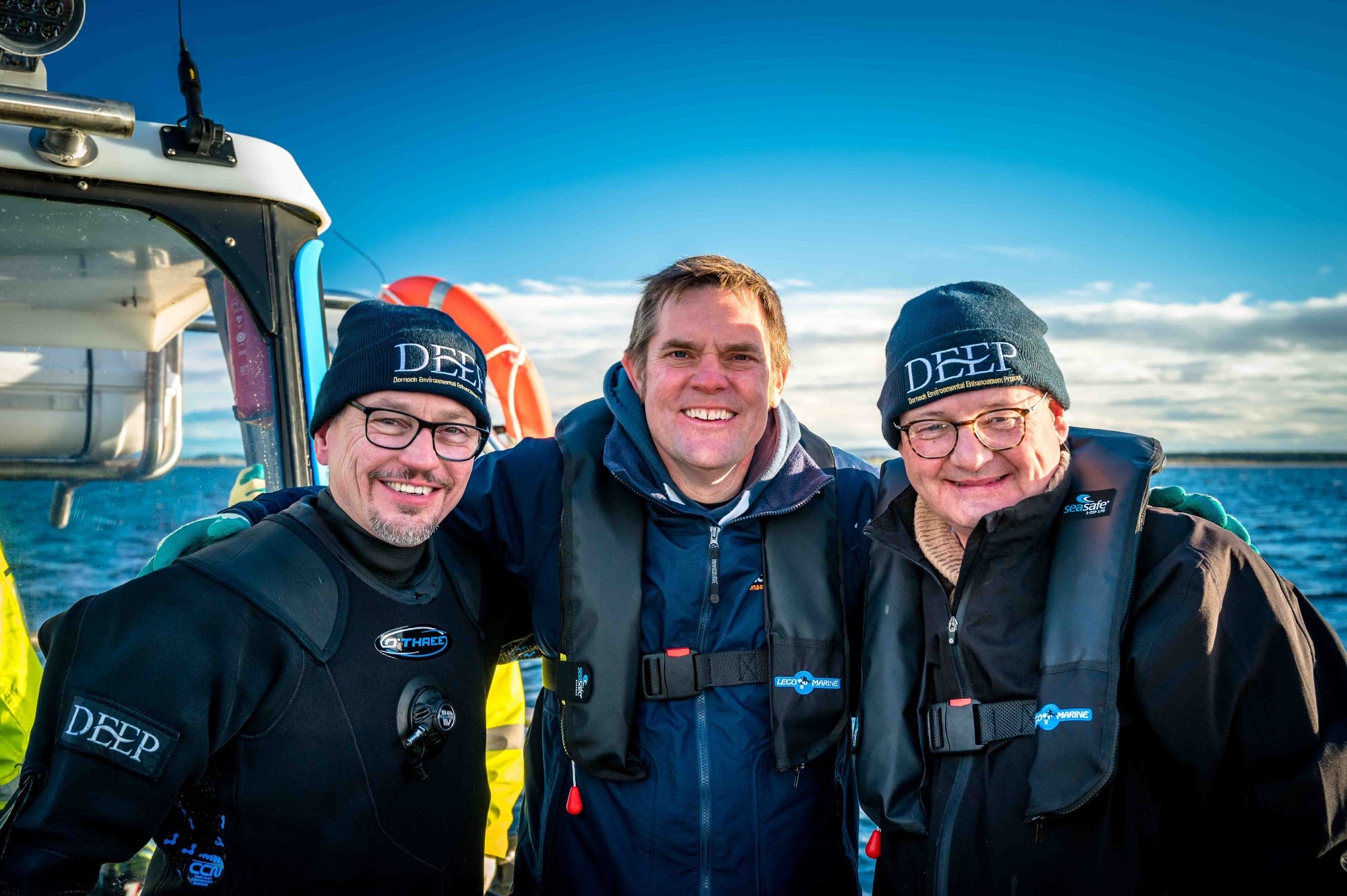New research from Heriot-Watt University in partnership with The Glenmorangie Distillery and the Marine Conservation Society has, for the first time, predicted the biodiversity gain of reintroducing European native oysters (Ostrea edulis).
 Image of (L-R) Professor Bill Sanderson, Heriot-Watt University, Calum Duncan, Marine Conservation Society, and Hamish Torrie, The Glenmorangie Company. Image Credit Charné Hawkes
Image of (L-R) Professor Bill Sanderson, Heriot-Watt University, Calum Duncan, Marine Conservation Society, and Hamish Torrie, The Glenmorangie Company. Image Credit Charné Hawkes
The innovative Dornoch Environmental Enhancement Project (DEEP), first initiated in 2014, seeks to reintroduce four million oysters by 2030 into the protected area of the Dornoch Firth on the banks of Glenmorangie Distillery in the Highlands of Scotland, UK. The species had become extinct, probably due to overfishing, over 100 years ago. The exemplar project aims to improve water quality, enhance marine biodiversity and increase carbon storage.
Oyster restoration efforts are growing across Europe as more is understood about the ‘ecosystem services’ provided by reefs which include a range of benefits to people and the environment. But with intact oyster reef habitats so rare, researchers have had limited data to work with to help predict the biodiversity benefits of this marine conservation work - until now.
Writing in peer-reviewed scientific journal PLOS ONE, Heriot-Watt researchers studied the biodiversity of Scotland’s last remaining native oyster fishery at Loch Ryan in south-west Scotland. The fishery has operated since 1701 and uses a rotational harvest system where different areas are fished each year and then left to repopulate for six years before they are fished again.
As well as giving the researchers a window into the past, studying Loch Ryan, which was made possible with support from Scottish Enterprise, has allowed the team to predict what a future reef in the Dornoch Firth reef could look like once oysters are fully restored. This was achieved by studying the effect of oyster reef development and biodiversity gain at different stages after the oyster habitat had been fished.
Lead author Naomi Kennon from Heriot-Watt University explains: “The findings from our research in Loch Ryan are extremely exciting, demonstrating that biodiversity will likely double over a decade once oyster restoration projects are complete. This means the population of species will increase in a balanced way. Our data has also shown a link between increased shell material as the oyster population grows and increased biodiversity.”
Professor Bill Sanderson from Heriot-Watt University continued: “These findings are significant for DEEP and for the Dornoch Firth but more broadly this research will help to inform the many marine conservation projects around the world that have taken inspiration from this exemplar project. This study is a rare example from a long-established dredge fishery whose practices appear to have allowed rare oyster habitat and the associated community to persist, thereby providing a valuable insight into the recovery of biodiversity in European oyster habitat restoration.”
In the study, three treatments were surveyed for faunal biodiversity, oyster shell density and oyster shell percentage cover. Treatments were plots that had been harvested one year previously, two years, and six years before the study began. The treatments were surveyed with SCUBA using a combination of video transects and photo quadrats. Modelling was used to predict changes in the Shannon-Wiener's Diversity index (a globally recognised and popular measure of diversity) over time since fishing.
Hamish Torrie, Glenmorangie’s CSR Communications Director, said: “Glenmorangie is dedicated to protecting and improving the beautiful surroundings of the Dornoch Firth which has been home to our Distillery for 180 years. The findings of this research demonstrate the potential for significant biodiversity gain through the restoration of native oyster reefs and will give DEEP’s partners great confidence as we drive to our next milestone of 200,000 oysters restored by end 2024.
Calum Duncan, Head of Conservation Scotland at the Marine Conservation Society said: “We are in a climate and nature emergency and need more than ever to boost marine ecosystem recovery. We’re proud to be a founding partner of this visionary project which demonstrates how powerful species restoration can be. The study in Loch Ryan shows that increasing the complexity of the seabed allows many species to find refuge in this living reef. We therefore look forward to thousands more native oysters being released in the Dornoch Firth, to attract even more biodiversity to the area.”
A short film to support the research can be viewed here.